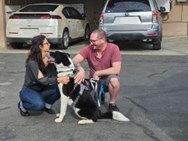Happy Tails Alerts
New LIVE Chat!
 We are excited to launch our new live chat feature on our website! Have questions about our services? Wondering what the best method of transport is for your pet? Simply click the tab on the bottom right-hand side of our webpage to message us!
We are excited to launch our new live chat feature on our website! Have questions about our services? Wondering what the best method of transport is for your pet? Simply click the tab on the bottom right-hand side of our webpage to message us!
Responses will be received as quickly as possible during business hours (7 am - 4 pm MST Mon - Fri). After hours, the chat feature will leave us a message and we will respond the next working day.
Featured Testimonial
 "I am writing to express my sincere gratitude and appreciation for the outstanding services provided by Happy Tails Travel during the transportation of our beloved Sparky to his new home.
"I am writing to express my sincere gratitude and appreciation for the outstanding services provided by Happy Tails Travel during the transportation of our beloved Sparky to his new home.
From our initial contact with Happy Tails Travel, Lizzie, our Pet Travel Specialist, demonstrated unparalleled professionalism and dedication. Lizzie's expertise and commitment were evident throughout the entire process, providing us with the confidence that Sparky was in the best possible hands. Her attention to detail, clear communication, and genuine care for animals made the entire experience seamless and stress-free."
Make sure to read the rest of Sparky's testimonial and our others here!
Summer Safety Tips for Pets
Summer Safety Tips for Pets from Happy Tails Travel
Warmer temperatures brings certain risks and health hazards for your furry friends. Follow these summer safety tips to keep your cats and dogs healthy and happy during the summer season!
Keep your pet hydrated
Just like humans, animals need lots of water when it’s hot outside!
-
Make sure you provide adequate shade and easy access to water at all times.
-
Limit your pet’s exercise to early morning or late evening when the temperature is cooler. If you go for a walk with your dog, make sure to bring a water bottle for yourself and your pet.
-
Remember, dogs don’t sweat like humans do! They also don’t respond to temperatures the same way. Fans don’t cool dogs the same way as it does humans, since dogs sweat primarily through their feet.
-
Take your dog’s temperature if you’re unsure if they are in danger. A dog’s temperature should not get over 104. If their temperature is above 104 degrees fahrenheit, your dog could be experiencing a heat stroke. Signs of heatstroke in dogs include heaving panting, glazed eyes, rapid heartbeat, difficulty breathing, excessive thirst, lethargy, fever, dizziness, lack of coordination, profuse salivation, vomiting, a deep red or purple tongue, seizure or unconsciousness. If your dog is showing signs of a heat stroke, the Humane Society recommends immediately moving your pet to a shaded or air-conditioned area. Apply ice packs or cold towels to their head, neck and chest. You can also run cold water over their entire head and body. Allow them to to drink small amounts of cool water at a time, or lick ice cubes. The next step is to take your dog into the veterinarian as soon as possible.
Beware of hot pavements or surfaces
Hot temperatures can create hot surfaces like sidewalks, patios and pavement that can be dangerous to your pets. Burns and blisters can occur on the pads of their paws, and can result in infections or other serious issues.
-
A quick way to check if the pavement is too hot for your pet to walk on is to place the back of your hand on the pavement for 5 seconds. If it’s too hot to hold your hand their the entire time, it’s too hot for your animal’s paws.
-
If you absolutely must walk them during hot temperatures, use special paw booties or stay in grassy areas.
-
Watch for signs of your pet not wanting to walk, or if they begin limping. This may be your pet telling you it’s too hot for their paws.
-
If you see a change in your dog’s paws to being red or pink, if they licking or chewing on the paws, or if blisters or missing pieces from the pad of the paw occur, take your dog to the vet immediately.
NEVER leave your pet in a car
Never leave your pet in the car, no matter how cool it seems, or even if it’s for a short amount of time. Temperatures inside a vehicle can rise almost 20 degrees in just 10 minutes, 30 degrees in 20 minutes, and even higher during longer amounts of time. After 60 minutes, the temperature in your car can be more than 40 degrees higher than the outside temperature. Death can occur quickly and painfully.
Watch for sudden changes in weather
Whether it’s humid, windy, or storming outside, different examples of severe summer weather can have an effect on your pet.
-
Humidity can make it more difficult for your pets to breathe comfortable. Animals pant to evaporate moisture from their lungs, which helps cool their body. When it’s humid, animals have a harder time cooling themselves, and their body temperature can rise to dangerous levels very quickly.
-
Pets can get storm anxiety in places where summer monsoons pop up with little notice. A tip to help them stay calm during a storm is to leave the TV or a radio on for background noise if you cannot be there, or simply offer them comfort and snuggles. Keep windows and curtains closed to reduce noise and block out lightning flashes.
-
Dogs often like to have a cave-like space to hide in to feel secure, so providing a crate or dark room can help ease their anxiety.
-
You can help train them out of storm anxiety by training them, and make them feel safe and comfortable with you when they are inside during a storm.
Summer foods to avoid feeding your pet family
While you can indulge in summer barbecues and goodies, your pets should not! Avoid feeding dogs these foods, as they include ingredients that are safe for humans, but toxic for dogs:
-
Grapes and Raisins
-
Chocolate, Coffee and Caffeine
-
Mushrooms, Onions, Garlic and Avocados
-
Alcohol
-
Citrus
-
Macadamia Nuts (or nuts of any kind)
-
Milk and Diary
-
Raw or Undercooked Meat or Eggs
Call or email us with questions, or if you have specific questions pertaining to Pet Travel during the summer! To learn more about us visit us at HappyTailsTravel.com where we safely ship pets all summer long.
